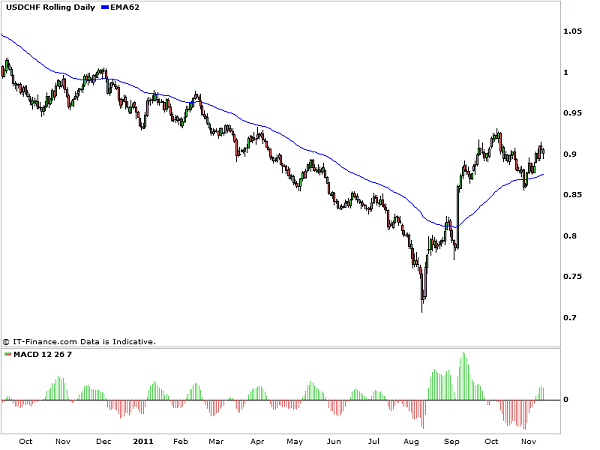
Stock markets rallied today and inevitably pushed the USD down from its demand-driven rally as the safe-haven for traders. Although this may be short-lived, it is interesting to look away from the EUR/USD to its alternative dollar-pairing. The USD-CHF is the fifth most traded currency pair in the world and it sits in the interesting position of consisting of two of the three global reserve currencies, of which the Japanese Yen is considered the third. With this status, its political stability, neutrality and the fact that the Swiss National Bank are against the CHF being used as a speculative currency it could be considered one of the more conservative currencies in forex. The fact that the Swiss National Bank are often in no mood to raise interest rates anytime soon creates, rather than answers, more questions as to what influences the CHF pairs.
The Swiss franc has a [intlink id=”2035″ type=”post”]positive correlation[/intlink] with both the GBP and the EUR and therefore the USDCHF often moves against the EURUSD. In the USD/CHF pairing the USD is the base currency whereas the Swiss franc is the counter currency. The pairing forms a literal comparison of these two currencies in regard to one another and both are seen as indicator currencies from two highly developed nations. For this reason traders value the movement of this pair as it can give a signal as to the overall sentiment and feeling of the forex market as a whole.
Switzerland is seen by the global economy as being characterised by low inflation and low unemployment. Alongside the neutrality, safe-haven and banking status of the CHF rarely moves against the USD with the output of domestic data. In other words, it is very much influenced by news, events and data emerging from the US to find its relative value. Although the USDCHF is highly correlated with the EURUSD and tends to negatively mirror this as a synthetic reflection of this pair, it also shares many of the behavioural characteristics of the GBPUSD to which it is negatively correlated. In terms of volatility and a tendency to create false break-outs, where price may swing confidently in one direction before reversing and trapping many traders on the wrong side of the trade, the USDCHF is very similar and can be observed in a comparable way. It also shares the characteristic of the GBPUSD in its disregard for technically strong areas of support and resistance. Often the USDCHF will swing though an area of clear resistance without returning to retest this previous price level which can frustrate technical traders.
Federal Reserve interest rates are a central to movements of the USDCHF as a subsidiary of the EURUSD. The relative value between the currencies is based on the differentials in the yields and ultimate earning potentials of the Federal Reserve and the Swiss National Bank. Alongside this, the announcement of Swiss GDP as a quarterly measure of the productivity and growth of the economy is often highly influential in establishing the overall health of the Swiss economy and gives an idea as to the future prospects for interest rate manipulation by the Swiss National Bank. However, the relative size of the Swiss economy compared to that of the US means that the most dramatic movements in price are often though the interpretation of Federal Reserve announcements and US data, rather than Swiss.
Comments (No)